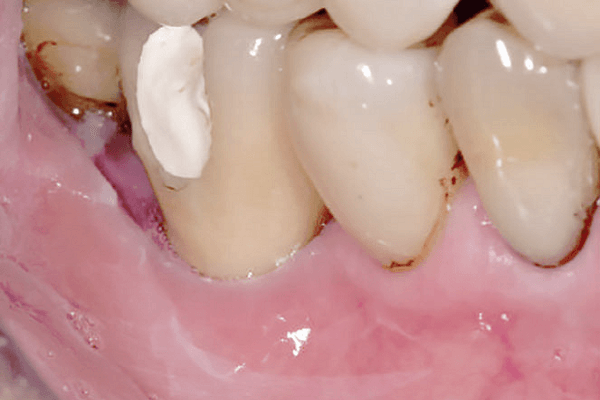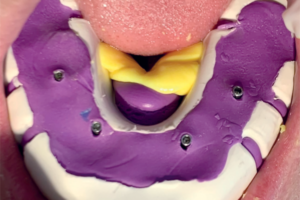RESUMO
Este relato de caso teve como objetivo apresentar uma terapia aplicada a um implante dentário mal posicionado na região do 46, com diagnóstico clínico e radiográfico de peri-implantite. Para o planejamento do caso, foi levada em consideração a vontade do paciente em manter o implante. Inicialmente, realizou-se drenagem do abscesso e raspagem da região para controle da infecção aguda e desconforto doloroso. Posteriormente, a intervenção terapêutica foi a descontaminação com pontas ultrassônicas convencionais, implantoplastia nas faces livres do implante com pontas diamantadas em alta rotação e terapia cirúrgica regenerativa do defeito ósseo peri-implantar, com substituto ósseo bovino desproteinizado e membrana de colágeno. Após a fase cirúrgica do tratamento, o paciente continua no programa de controle periodontal e peri- -implantar a cada quatro meses. Após dois anos de acompanhamento, o sítio do implante apresentou-se saudável, sendo possível devolver função e estética para o paciente. Pôde-se concluir que a terapia aplicada para tratamento da peri-implantite neste caso clínico foi eficaz, resultando em tecidos peri-implantares saudáveis ao longo do tempo.
Palavras-chave – Implante dentário; Peri-implantite; Implantoplastia; Regeneração óssea guiada.
ABSTRACT
Peri-implantitis is the inflammation of the peri-implant mucosa and the progressive loss of supporting bone. Despite being a prevalent clinical condition, there is no consensus in literature on an ideal treatment protocol. This case report aims to present a therapy applied to a buccally positioned dental implant, in the region of 46, with clinical and radiographic diagnosis of peri-implantitis. In planning phase, the patient’s willingness to maintain the implant was taken into account. Initially, the abscess was drained, and the region was debrided to control the acute infection and pain. Subsequently, the therapeutic intervention elected was decontamination with conventional ultrasonic scaler tips, implantoplasty on the exposed surface of the implant with high speed diamond burrs, and then a regenerative surgical therapy of the peri-implant bone defect was performed with a deproteinized bovine bone substitute and collagen membrane. After the surgical phase, the patient was enrolled on a periodontal and peri-implant maintenance program every 4 months. After 2 years of follow-up, the implant site was healthy and it was possible to restore function and aesthetic to the patient. Therefore, it can be concluded that the therapy for the peri-implantitis in this case was effective, resulted in healthy tissues over time.
Key words – Dental implant; Peri-implantitis; Implantoplasty; Guided bone regeneration.
Lorem ipsum dolor sit amet, consectetur adipiscing elit. Ut elit tellus, luctus nec ullamcorper mattis, pulvinar dapibus leo.





